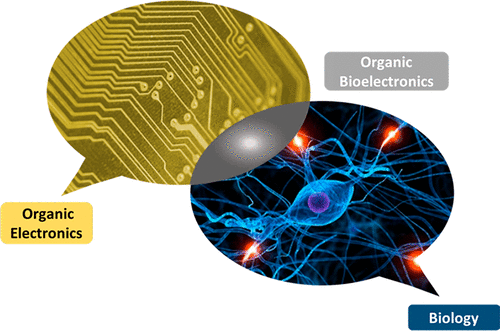当前位置:
X-MOL 学术
›
Acc. Chem. Res.
›
论文详情
Our official English website, www.x-mol.net, welcomes your feedback! (Note: you will need to create a separate account there.)
Conjugated Polymers in Bioelectronics
Accounts of Chemical Research ( IF 18.3 ) Pub Date : 2018-06-06 00:00:00 , DOI: 10.1021/acs.accounts.7b00624 Sahika Inal 1 , Jonathan Rivnay 2, 3 , Andreea-Otilia Suiu 4 , George G. Malliaras 5 , Iain McCulloch 4, 6
Accounts of Chemical Research ( IF 18.3 ) Pub Date : 2018-06-06 00:00:00 , DOI: 10.1021/acs.accounts.7b00624 Sahika Inal 1 , Jonathan Rivnay 2, 3 , Andreea-Otilia Suiu 4 , George G. Malliaras 5 , Iain McCulloch 4, 6
Affiliation

|
The emerging field of organic bioelectronics bridges the electronic world of organic-semiconductor-based devices with the soft, predominantly ionic world of biology. This crosstalk can occur in both directions. For example, a biochemical reaction may change the doping state of an organic material, generating an electronic readout. Conversely, an electronic signal from a device may stimulate a biological event. Cutting-edge research in this field results in the development of a broad variety of meaningful applications, from biosensors and drug delivery systems to health monitoring devices and brain–machine interfaces. Conjugated polymers share similarities in chemical “nature” with biological molecules and can be engineered on various forms, including hydrogels that have Young’s moduli similar to those of soft tissues and are ionically conducting. The structure of organic materials can be tuned through synthetic chemistry, and their biological properties can be controlled using a variety of functionalization strategies. Finally, organic electronic materials can be integrated with a variety of mechanical supports, giving rise to devices with form factors that enable integration with biological systems. While these developments are innovative and promising, it is important to note that the field is still in its infancy, with many unknowns and immense scope for exploration and highly collaborative research. The first part of this Account details the unique properties that render conjugated polymers excellent biointerfacing materials. We then offer an overview of the most common conjugated polymers that have been used as active layers in various organic bioelectronics devices, highlighting the importance of developing new materials. These materials are the most popular ethylenedioxythiophene derivatives as well as conjugated polyelectrolytes and ion-free organic semiconductors functionalized for the biological interface. We then discuss several applications and operation principles of state-of-the-art bioelectronics devices. These devices include electrodes applied to sense/trigger electrophysiological activity of cells as well as electrolyte-gated field-effect and electrochemical transistors used for sensing of biochemical markers. Another prime application example of conjugated polymers is cell actuators. External modulation of the redox state of the underlying conjugated polymer films controls the adhesion behavior and viability of cells. These smart surfaces can be also designed in the form of three-dimensional architectures because of the processability of conjugated polymers. As such, cell-loaded scaffolds based on electroactive polymers enable integrated sensing or stimulation within the engineered tissue itself. A last application example is organic neuromorphic devices, an alternative computing architecture that takes inspiration from biology and, in particular, from the way the brain works. Leveraging ion redistribution inside a conjugated polymer upon application of an electrical field and its coupling with electronic charges, conjugated polymers can be engineered to act as artificial neurons or synapses with complex, history-dependent behavior. We conclude this Account by highlighting main factors that need to be considered for the design of a conjugated polymer for applications in bioelectronics—although there can be various figures of merit given the broad range of applications, as emphasized in this Account.
中文翻译:

生物电子学中的共轭聚合物
有机生物电子学的新兴领域将基于有机半导体的设备的电子世界与柔软的,主要是离子的生物学世界联系起来。这种串扰可以在两个方向上发生。例如,生化反应可能会改变有机材料的掺杂状态,从而产生电子读数。相反,来自设备的电子信号可能会刺激生物事件。该领域的前沿研究导致了广泛的有意义的应用程序的开发,从生物传感器和药物输送系统到健康监测设备和脑机接口。共轭聚合物在化学“自然”方面与生物分子具有相似性,可以以多种形式进行工程改造,包括杨氏模量与软组织的杨氏模量相似且具有离子导电性的水凝胶。可以通过合成化学来调节有机材料的结构,并且可以使用多种功能化策略来控制其生物学特性。最后,有机电子材料可以与各种机械支架集成在一起,从而产生了具有可与生物系统集成的外形尺寸的设备。尽管这些发展具有创新性和前景可观,但必须指出的是,该领域仍处于起步阶段,具有许多未知数,并且探索和高度协作研究的范围非常广泛。该帐户的第一部分详细介绍了使共轭聚合物成为出色的生物界面材料的独特性能。然后,我们概述了已在各种有机生物电子设备中用作活性层的最常见的共轭聚合物,强调开发新材料的重要性。这些材料是最流行的乙二氧基噻吩衍生物以及为生物界面功能化的共轭聚电解质和无离子有机半导体。然后,我们讨论最先进的生物电子设备的几种应用和工作原理。这些设备包括用于感应/触发细胞电生理活动的电极,以及用于感应生化标记物的电解质门控场效应和电化学晶体管。共轭聚合物的另一个主要应用实例是细胞致动器。底层共轭聚合物薄膜的氧化还原状态的外部调节控制细胞的粘附行为和生存能力。由于共轭聚合物的可加工性,也可以将这些智能表面设计为三维结构形式。这样,基于电活性聚合物的细胞负载的支架能够在工程组织本身内进行整合的感测或刺激。最后一个应用示例是有机神经形态设备,这是一种从生物学尤其是从大脑工作方式中获得启发的替代计算体系结构。利用电场作用下共轭聚合物内部的离子再分布及其与电荷的耦合,可以将共轭聚合物工程化为人工神经元或具有复杂的,依赖于历史的行为的突触。
更新日期:2018-06-06
中文翻译:

生物电子学中的共轭聚合物
有机生物电子学的新兴领域将基于有机半导体的设备的电子世界与柔软的,主要是离子的生物学世界联系起来。这种串扰可以在两个方向上发生。例如,生化反应可能会改变有机材料的掺杂状态,从而产生电子读数。相反,来自设备的电子信号可能会刺激生物事件。该领域的前沿研究导致了广泛的有意义的应用程序的开发,从生物传感器和药物输送系统到健康监测设备和脑机接口。共轭聚合物在化学“自然”方面与生物分子具有相似性,可以以多种形式进行工程改造,包括杨氏模量与软组织的杨氏模量相似且具有离子导电性的水凝胶。可以通过合成化学来调节有机材料的结构,并且可以使用多种功能化策略来控制其生物学特性。最后,有机电子材料可以与各种机械支架集成在一起,从而产生了具有可与生物系统集成的外形尺寸的设备。尽管这些发展具有创新性和前景可观,但必须指出的是,该领域仍处于起步阶段,具有许多未知数,并且探索和高度协作研究的范围非常广泛。该帐户的第一部分详细介绍了使共轭聚合物成为出色的生物界面材料的独特性能。然后,我们概述了已在各种有机生物电子设备中用作活性层的最常见的共轭聚合物,强调开发新材料的重要性。这些材料是最流行的乙二氧基噻吩衍生物以及为生物界面功能化的共轭聚电解质和无离子有机半导体。然后,我们讨论最先进的生物电子设备的几种应用和工作原理。这些设备包括用于感应/触发细胞电生理活动的电极,以及用于感应生化标记物的电解质门控场效应和电化学晶体管。共轭聚合物的另一个主要应用实例是细胞致动器。底层共轭聚合物薄膜的氧化还原状态的外部调节控制细胞的粘附行为和生存能力。由于共轭聚合物的可加工性,也可以将这些智能表面设计为三维结构形式。这样,基于电活性聚合物的细胞负载的支架能够在工程组织本身内进行整合的感测或刺激。最后一个应用示例是有机神经形态设备,这是一种从生物学尤其是从大脑工作方式中获得启发的替代计算体系结构。利用电场作用下共轭聚合物内部的离子再分布及其与电荷的耦合,可以将共轭聚合物工程化为人工神经元或具有复杂的,依赖于历史的行为的突触。


























 京公网安备 11010802027423号
京公网安备 11010802027423号